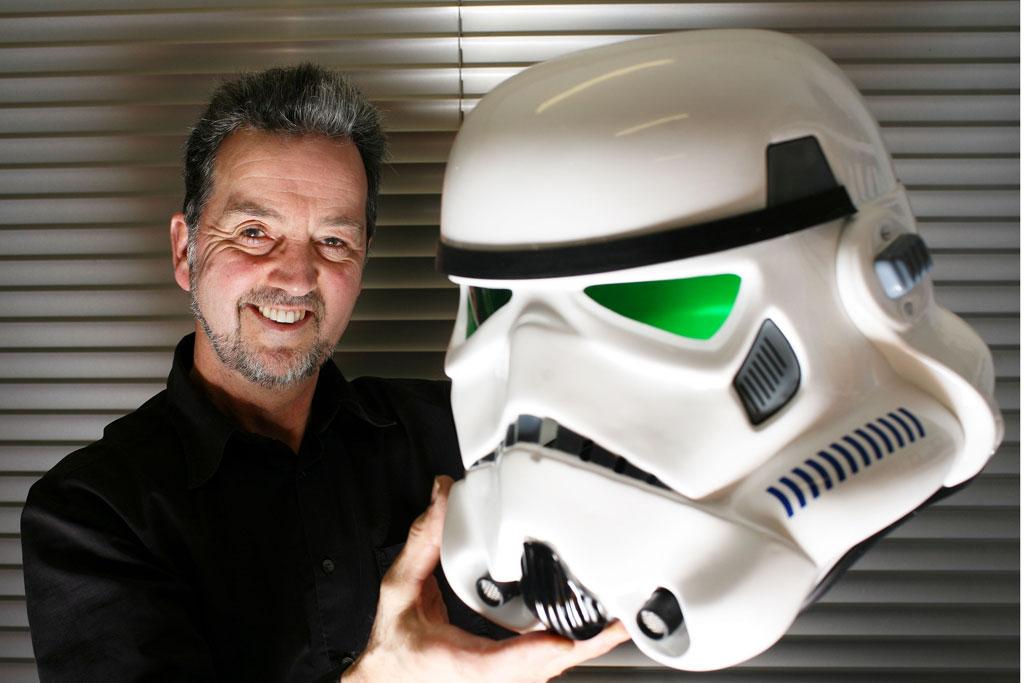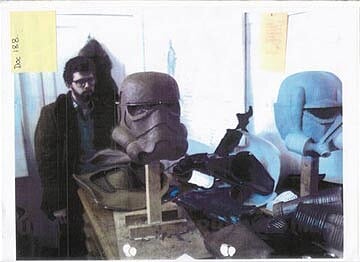The year is 1972, and British industrial designer Andrew Ainsworth has just set up Shepperton Design Studios where he manufactures his own motor cars. Four years into his business, he meets Star Wars creator George Lucas through a next-door neighbor in Twickenham, UK. Impressed with the Brit’s work, Lucas commissioned Ainsworth to design and manufacture 56 full stormtrooper suits along with a number of other props and costumes for use in Star Wars: Episode IV – A New Hope.
Fast forward to 2002 and the Star Wars franchise is a huge hit, the original trilogy has launched together with an assortment of TV shows, video games, and a mountain of licensed merchandise. At this point, Ainsworth had produced 19 more stormtrooper helmets for private collectors in the U.S., which prompted George Lucas’ Lucasfilm studio to contact him. In 2005, Lucasfilm denied Ainsworth’s involvement in the production of the costumes and sued for a whopping $20M in damages over the rights to the stormtrooper design.
After seven years of legal battles spanning two continents, Disney bought the Star Wars franchise in 2012 and accepted a £90,000 settlement from Ainsworth to close the case. Since retaining the right to sell the design in the UK, Ainsworth has been operating out of the same design studio in Twickenham, hand-making and selling Original Stormtrooper replicas and merchandise.
He has recently partnered up with 3D printing file marketplace MyMiniFactory to run a series of design competitions surrounding the Original Stormtrooper. Users are able to design their own versions based on a theme and then have them approved for monetization on the MyMiniFactory marketplace.
Being a fan of his work, I sat down for a Q&A session with Andrew Ainsworth to discuss 3D printing, the Original Stormtrooper, and the world of design and manufacturing in 2020.

3D Printing Industry: What made you decide to partner up with MyMiniFactory and bring the Original Stormtroopers to the 3D printing community?
Andrew Ainsworth: There is a lot of interest in the Original Stormtrooper product range (which includes ceramics, toiletries, t-shirts, cake, Easter eggs, mini-speakers and more) and when we saw the MyMiniFactory platform, we knew that the community would embrace the opportunity to apply their creativity to the iconic stormtrooper character.
3DPI: What are your thoughts on 3D printing?
AA: Very good, we are open to new things, but it’s not that new – I saw a Russian machine dated 1870 that effectively did 3D printing and layered thin wood veneers. 3D printing can leave sharp edges and lines, so if you can get hold of some MEK (methyl ethyl ketone) you can use it over the top of the ABS to smooth it down and blend it all in, or to weld parts together.
3DPI: Do you work with 3D printing technology now or prefer to stick with traditional manufacturing methods?
AA: Both – we use Printfarm, but truthfully 3D printing is really slow, so not good for mass production. We find it good for modelling and making metal molds for components and we do some production, like the internal components of the R2 Droid for example, but for anything sculptural like the outside of the Original Stormtrooper armour where there are 40 components, it is much quicker to produce using traditional vacuum forming methods.
3DPI: Was there any particular object or person in your life that inspired the Original Stormtrooper design or did it just come to you one day?
AA: All I was given was a drawing from Ralph Mcquarrie (conceptual designer and illustrator for the movie) and I set about making a futuristic character that was never meant to be human. My vision was that it almost evolved like that, similar to an armadillo. I thought there was no point having WW2 style ammunition if they were from the future so I had to come up with shapes that simulated futuristic ammo. I thought that the stormtrooper would be from a toxic planet so would need breathing apparatus and would be able to communicate with technology on the ears. You have to remember this was at a time before mobile phones, so my vision of the future was based on what technology I was surrounded with at the time. At that time I was designing cars and people still say to me that they look futuristic actually.
Turns out Ralph McQuarrie hated my stormtrooper, he said the stormtrooper was meant to be mechanical and sharp, but that I had smoothed it out. I made them slick, smooth and shiny on purpose so they could move fast, not like humans. Since I had no brief, I had to make it up and even though Lucas’ vision was more like individuals with muddied canvas clothes and backpacks, when he saw my stormtroopers he realised they would work.

3DPI: Can you share some steps designers can take to protect their work in this digital age? In what situation should a design be made open-source?
AA: The best protection is to have a successful character that can’t be easily replicated. Digital watermarking should become sufficiently sophisticated that designs can be chargeable if they are sufficiently desirable. If you want a design to gain traction, open-source would probably be the best way to go at first but it might make sense to withhold some elements of the design for a paid-for version.
3DPI: Of all the trooper designs, new and old, which is your favourite? (sandtrooper, snowtrooper, scout trooper etc.)
AA: There is only one. All the rest are copies!
3DPI: How is your relationship with George Lucas these days in light of the stormtrooper lawsuit?
AA: The case was settled when Disney took over and since then we have been able to co-exist with very little conflict. The Original Stormtrooper is very much a separate entity living outside the Star Wars universe and appealing to a consumer who wants to cherish the design element of the character rather than the Star Wars franchise.
3DPI: Ten ewoks versus one wookiee. Who wins in a bare knuckle fight?
AA: Difficult to say but if stormtroopers were to try and break up the fracas, there would soon be some rhythms beaten out on a marimba made of empty helmets!
Even after almost 50 years of industrial design and manufacturing under his belt, Ainsworth is still doing what he loves to this day and can be found in his design studio in Twickenham. His full range of Original Stormtrooper products can be found here. Also, designers who wish to take part in the MyMiniFactory design competition can do so here.

The nominations for the 2020 3D Printing Industry Awards are now open. Who do you think should make the shortlists for this year’s show? Have your say now.
Subscribe to the 3D Printing Industry newsletter for the latest news in additive manufacturing. You can also stay connected by following us on Twitter and liking us on Facebook.
Looking for a career in additive manufacturing? Visit 3D Printing Jobs for a selection of roles in the industry.
Featured image shows Andrew Ainsworth and the Original Stormtrooper helmet. Photo via Andrew Ainsworth.



